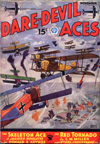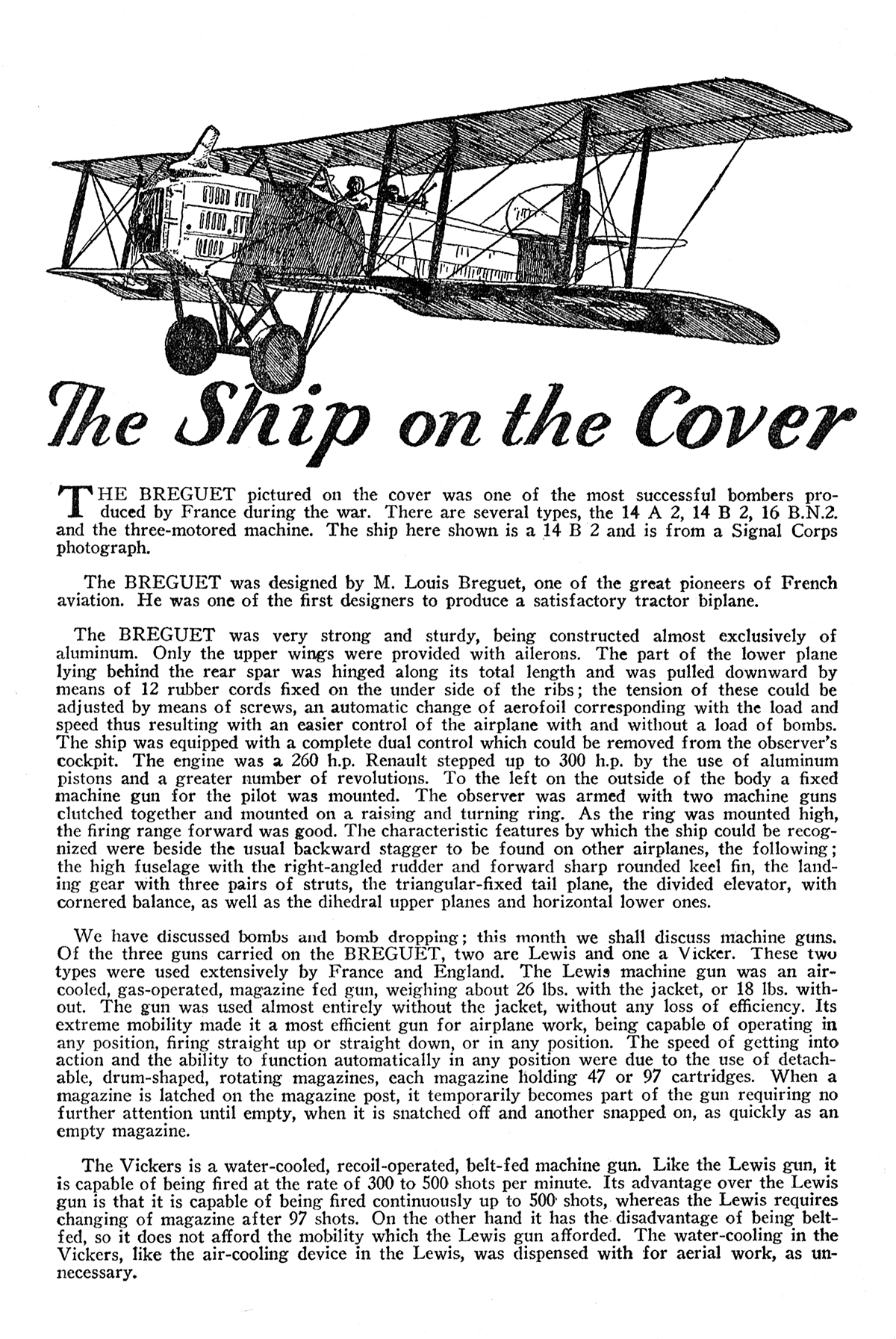“The Breguet” by Frederick Blakeslee
Frederick Blakeslee painted all the covers for the entire run of Dare-Devil Aces. And each of those covers had a story behind it. This time, Blakeslee presents us with more of the approach he used for the covers he painted for Battle Aces—telling us about the ship on cover of the November 1934 cover for Dare-Devil Aces. . . .
 THE BREGUET pictured on the cover was one of the most successful bombers produced by France during the war. There are several types, the 14 A 2, 14 B 2, 16 B.N.2. and the three-motored machine. The ship here shown is a 14 B 2 and is from a Signal Corps photograph.
THE BREGUET pictured on the cover was one of the most successful bombers produced by France during the war. There are several types, the 14 A 2, 14 B 2, 16 B.N.2. and the three-motored machine. The ship here shown is a 14 B 2 and is from a Signal Corps photograph.
The BREGUET was designed by M. Louis Breguet, one of the great pioneers of French aviation. He was one of the first designers to produce a satisfactory tractor biplane.
The BREGUET was very strong and sturdy, being constructed almost exclusively of aluminum. Only the upper wings were provided with ailerons. The part of the lower plane lying behind the rear spar was hinged along its total length and was pulled downward by means of 12 rubber cords fixed on the under side of the ribs; the tension of these could be adjusted by means of screws, an automatic change of aerofoil corresponding with the load and speed thus resulting with an easier control of the airplane with and without a load of bombs. The ship was equipped with a complete dual control which could be removed from the observer’s cockpit. The engine was a 260 h.p. Renault stepped up to 300 h.p. by the use of aluminum pistons and a greater number of revolutions. To the left on the outside of the body a fixed machine gun for the pilot was mounted. The observer was armed with two machine guns clutched together and mounted on a raising and turning ring. As the ring was mounted high, the firing range forward was good. The characteristic features by which the ship could be recognized were beside the usual backward stagger to be found on other airplanes, the following; the high fuselage with the right-angled rudder and forward sharp rounded keel fin, the landing gear with three pairs of struts, the triangular-fixed tail plane, the divided elevator, with cornered balance, as well as the dihedral upper planes and horizontal lower ones.
We have discussed bombs and bomb dropping; this month we shall discuss machine guns. Of the three guns carried on the BREGUET, two arc Lewis and one a Vicker. These two types were used extensively by France and England. The Lewis machine gun was an air-cooled, gas-operated, magazine fed gun, weighing about 26 lbs. with the jacket, or 18 lbs. without. The gun was used almost entirely without the jacket, without any loss of efficiency. Its extreme mobility made it a most efficient gun for airplane work, being capable of operating in any position, firing straight up or straight down, or in any position. The speed of getting into action and the ability to function automatically in any position were due to the use of detachable, drum-shaped, rotating magazines, each magazine holding 47 or 97 cartridges. When a magazine is latched on the magazine post, it temporarily becomes part of the gun requiring no further attention until empty, when it is snatched off and another snapped on, as quickly as an empty magazine.
The Vickers is a water-cooled, recoil-operated, belt-fed machine gun. Like the Lewis gun, it is capable of being fired at the rate of 300 to 500 shots per minute. Its advantage over the Lewis gun is that it is capable of being fired continuously up to 500 shots, whereas the Lewis requires changing of magazine after 97 shots. On the other hand it has the disadvantage of being belt-fed, so it does not afford the mobility which the Lewis gun afforded. The water-cooling in the Vickers, like the air-cooling device in the Lewis, was dispensed with for aerial work, as unnecessary.

“The Breguet: The Ship on the Cover” by Frederick Blakeslee
(November 1934, Dare-Devil Aces)
Next time, Mr. Blakeslee brings us the fanciful tale of “The Flying Torpedo” for the December 1934 cover. Be sure not to miss it.




